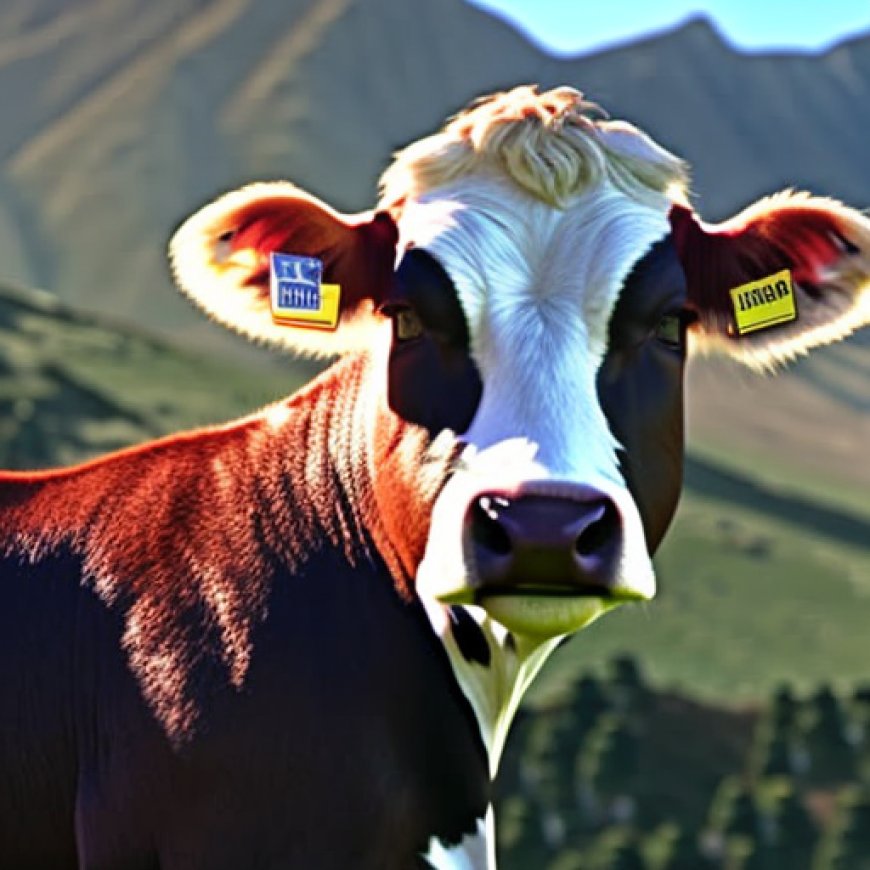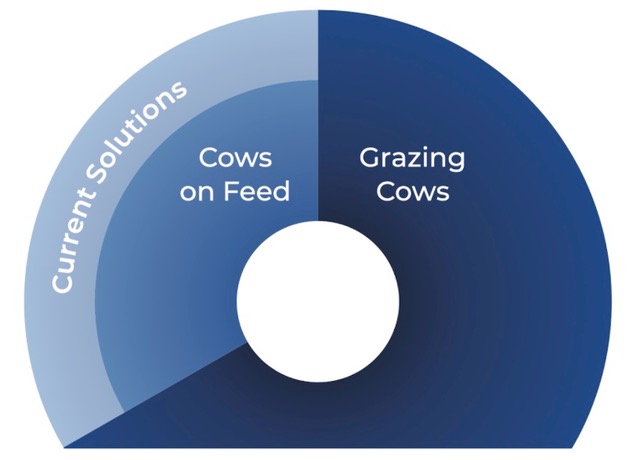Climate-Smart Cattle: US Research and Development Will Improve Animal Productivity, Address Greenhouse Gases, and Hasten Additional Market Solutions – Federation of American Scientists
Climate-Smart Cattle: US Research and Development Will Improve ... Federation Of American Scientists


Summary
Cattle in the United States release the greenhouse gas methane (known as “enteric methane”) from their digestive systems, which is equivalent to the amount of methane that leaks from fossil fuel infrastructure. Addressing enteric methane in cattle represents an opportunity to reduce the U.S. greenhouse gas footprint by 3% and simultaneously improve cattle productivity by ~6%. However, current solutions only address, at most, 10% of these emissions, and the U.S. has spent under $5m per year on R&D over the past five years to address this critical climate area.

Challenge & Opportunity
Cattle and other ruminants digest their food via anaerobic (oxygen-free) fermentation. This unique system allows them to digest roughage such as grasses and other forage and transform it into meat and milk. But it also generates methane. Cattle release on average 6% of the calories they eat as methane, a substantial loss in their potential meat and milk productivity. This methane is in addition to the methane emitted by their manure.
An invisible and odorless gas, methane is a powerful greenhouse gas that is responsible for 0.5°C of the 1°C of modern global warming (based on the 2010-2019 average). One-third of U.S. anthropogenic methane emissions come from cattle and other ruminants. Solutions may be able to be developed that both disrupt enteric methane production while also increasing cattle productivity. That would help reduce global temperatures and provide benefits for both producers and consumers. Currently, there are a few tested and marketable solutions that use chemicals to disrupt methane-creating microbes in the cattle’s first stomach (the rumen). These are important solutions that need to be evaluated for regulatory approval. However, additional research and development must also be done, to help address the majority of emissions that don’t yet have available solutions, particularly from cattle grazing in pastures. Additional work is also needed to continue developing solutions that consistently lead to a productivity benefit. Focused scientific research could deepen our understanding of cattle metabolism, and advance new solutions for reducing enteric methane further.
Progress on this front also requires improved research tools to measure how much methane cattle emit and relate these methane emissions to their productivity and intake of feed and forage. Access to such research tools enables researchers and innovators to develop and evaluate new solutions. Methane emissions rates vary widely between cattle on the same farm of the same breed, as well as across breeds. Currently these tools are expensive and not widely available. For example, the primary tool available measures twenty cattle per day, costs ~$100,000, and can be found at only a handful of research institutions. That presents a practical problem of access not only for producers but also for non-specialist scientific innovators. Making those tools more accessible, for example via fee-for-service centers at leading U.S. Land Grant institutes, would make them more affordable for producers and researchers. That would help unlock the creativity of U.S. innovators, and provide evidence that their solutions have a positive climate impact and are feasible for producers and acceptable to consumers.
Even when new solutions are found and proven, innovators still face a 10-year FDA approval process. This is uncompetitive and restrictive compared to other countries. Since much faster approval is possible in Australia, Brazil, and Europe, innovators have an incentive to launch their products and build their businesses there rather than in the USA. And as climate-aware export markets develop, slow FDA approval will cost U.S. producers market share and market opportunity. We therefore recommend that the FDA be given authority and direction to evaluate new methane-reducing products for safety on an accelerated timeline, while maintaining critical human and animal safety standards. This would help the U.S. position itself as a global leader in a potential multi-billion dollar market while upholding its climate commitments.
Minimizing peak temperatures requires livestock enteric methane research today.

Plan of Action
I. FUND BASIC & APPLIED LIVESTOCK ENTERIC METHANE RESEARCH
Total Funds Needed: $50,000,000 per year
Developing science-based, effective livestock enteric methane solutions depend on
SDGs, Targets, and Indicators
-
SDG 13: Climate Action
- Target 13.2: Integrate climate change measures into national policies, strategies, and planning
- Target 13.3: Improve education, awareness-raising, and human and institutional capacity on climate change mitigation, adaptation, impact reduction, and early warning
- Indicator 13.2.1: Number of countries that have integrated mitigation, adaptation, impact reduction, and early warning into primary, secondary, and tertiary curricula
- Indicator 13.3.1: Number of countries that have communicated the strengthening of institutional, systemic, and individual capacity-building to implement adaptation, mitigation, and technology transfer
-
SDG 2: Zero Hunger
- Target 2.4: By 2030, ensure sustainable food production systems and implement resilient agricultural practices that increase productivity and production
- Indicator 2.4.1: Proportion of agricultural area under productive and sustainable agriculture
-
SDG 9: Industry, Innovation, and Infrastructure
- Target 9.5: Enhance scientific research, upgrade the technological capabilities of industrial sectors in all countries, in particular developing countries, including, by 2030, encouraging innovation and substantially increasing the number of research and development workers per 1 million people and public and private research and development spending
- Indicator 9.5.1: Research and development expenditure as a proportion of GDP
Table: SDGs, Targets, and Indicators
| SDGs | Targets | Indicators |
|---|---|---|
| SDG 13: Climate Action | Target 13.2: Integrate climate change measures into national policies, strategies, and planning | Indicator 13.2.1: Number of countries that have integrated mitigation, adaptation, impact reduction, and early warning into primary, secondary, and tertiary curricula |
| SDG 13: Climate Action | Target 13.3: Improve education, awareness-raising, and human and institutional capacity on climate change mitigation, adaptation, impact reduction, and early warning | Indicator 13.3.1: Number of countries that have communicated the strengthening of institutional, systemic, and individual capacity-building to implement adaptation, mitigation, and technology transfer |
| Target 13.3: Improve education, awareness-raising, and human and institutional capacity on climate change mitigation, adaptation, impact reduction, and early warning | Indicator 13.3.1: Number of countries that have communicated the strengthening of institutional, systemic, and individual capacity-building to implement adaptation, mitigation, and technology transfer | |
| SDG 2: Zero Hunger | Target 2.4: By 2030, ensure sustainable food production systems and implement resilient agricultural practices that increase productivity and production | Indicator 2.4.1: Proportion of agricultural area under productive and sustainable agriculture |
| SDG 9: Industry, Innovation, and Infrastructure | Target 9.5: Enhance scientific research, upgrade the technological capabilities of industrial sectors in all countries, in particular developing countries, including, by 2030, encouraging innovation and substantially increasing the number of research and development workers per 1 million people and public and private research and development spending | Indicator 9.5.1: Research and development expenditure as a proportion of GDP |
Behold! This splendid article springs forth from the wellspring of knowledge, shaped by a wondrous proprietary AI technology that delved into a vast ocean of data, illuminating the path towards the Sustainable Development Goals. Remember that all rights are reserved by SDG Investors LLC, empowering us to champion progress together.
Source: fas.org

Join us, as fellow seekers of change, on a transformative journey at https://sdgtalks.ai/welcome, where you can become a member and actively contribute to shaping a brighter future.







